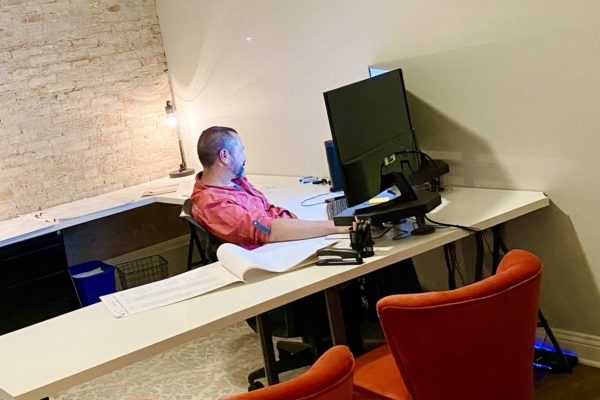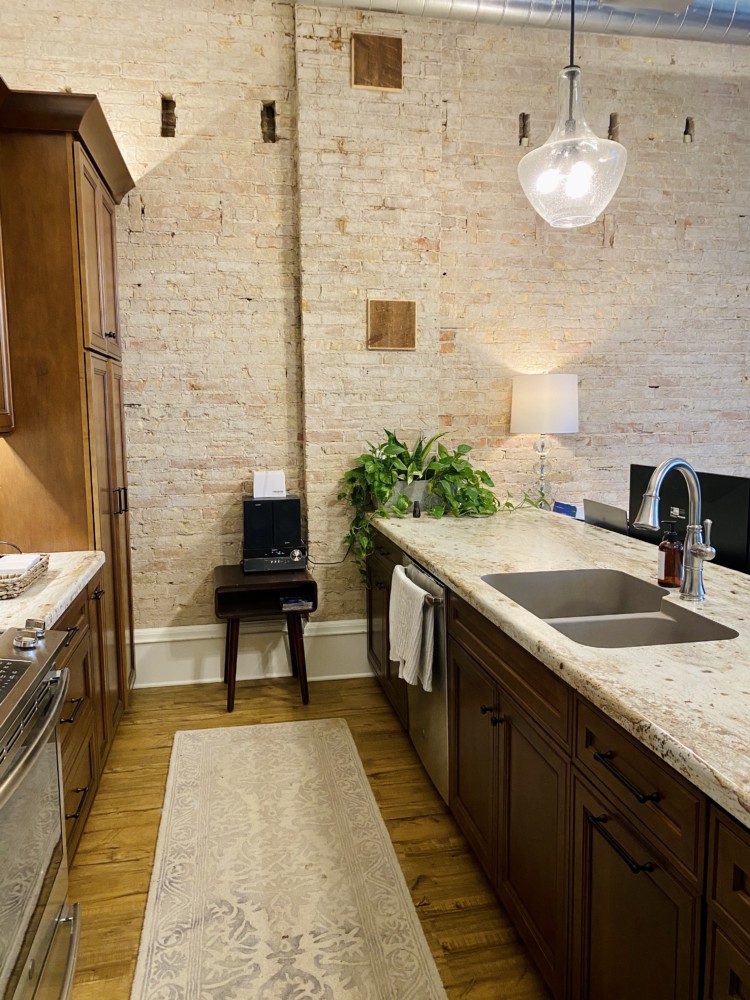Office Space Reimagined
As the nature of work evolves along with the pandemic, so do the office needs of Fox Cities businesses
Amy James recently decided to “home from work,” a concept she believes more businesses will adopt as the current COVID-19 pandemic continues.
James and her husband, Adam, co-own Vision Architecture which employs one other person. The pandemic forced them all to work from home last spring, which raised questions on the necessity and functionality of their oversized office space. The architectural firm had been operating out of a traditional four-story commercial building, complete with an elevator and restrooms shared by the other building tenants.
With their lease soon to expire and public health concerns at the forefront of their minds, James and her colleagues started to explore other office options.
“We started to see changes with people not riding the elevator together and avoiding the shared restrooms,” she says. “We started thinking, ‘Is this the right layout for us? Do we need all these workstations?’”
James says working from home was nice at first, but with six children, two dogs, two pet rabbits and a cat underfoot, it was clear the business needed a distinct space. They toured other offices and even contemplated converting a greenhouse at their home into an office.
Ultimately, the Jameses decided to relocate their business in July to an apartment in downtown Neenah on Wisconsin Avenue. This solution provides the best of both worlds – the comforts and amenities of working from home, but without the distractions.
Vision Architecture’s new “office” features a full kitchen for making breakfast on hectic mornings or entertaining clients. There is not a conference table in sight. Instead, James meets with clients in the comfort of a living room with a large TV that can display renderings and talks through projects in a relaxed atmosphere that’s more conducive to idea generation.
James says renting the apartment provides more flexibility in the lease. Here the lease is one year, as opposed to her three-year commercial lease. Flexibility during uncertain economic times provides her with peace of mind. It also provides advantages from a health perspective, which was important to James. The apartment has a controlled entrance so it’s easier to monitor who comes and goes.
“For me, [the pandemic] weighed heavily on the decision. It made me far more cognizant of every surface I touch and person I interact with throughout the day,” she says. “It’s not only a good location for us, but a good situation for us to keep staff safe and be able to operate in a normal way. I feel safe coming to work here because to some extent I can control my exposure.”
James isn’t alone in her thinking. COVID-19 has caused many businesses, large and small, to rethink their current office needs. According to a Gallup poll released in April, 62 percent of employed Americans say they worked from home during the crisis, a number that doubled since mid-March. With remote work on the rise and social distancing a priority, businesses of all sizes are reconsidering what they need to make their offices work for the future, whether that’s a standard office lease, co-working space or none at all due to continued remote work.
Brenda Leopold is the founder of World HeadQuarters, a coworking space and business support resource with locations in Appleton and Oshkosh. Leopold has run five home-based businesses over the last 25 years, but it’s taken a pandemic for the general public to understand the importance of the support offered by World HeadQuarters to small businesses, entrepreneurs and remote workers.
“People love the idea of working from home, but our society was never built to support businesses and employees working from home,” Leopold says. “COVID has made our case even stronger. For the first time in my career, people really get what I’m trying to do.”
Coworking memberships at World HeadQuarters come in three tiers, with increasing benefits like administrative support and reserved workspace time blocks. Members have access to shared and private workspaces, meeting rooms, business services and even child care.
Since the pandemic took hold, Leopold says the type of members coming to World HeadQuarters hasn’t changed, but their priorities have.
“The biggest shift for us has been people are buying more now on relationships and connections, even if they are only virtual,” Leopold says. “A year ago we were selling space. Now it’s 100 percent about connection and feeling safe.”
With more workers removed from the office setting, members are appreciating the “water cooler experience” they can have at a coworking space, Leopold says. Members can participate in virtual networking events and benefit from safe interaction with other members.
“We can control access in and out of the space, because it’s on a reservation basis,” Leopold says. “[Members] have comfort knowing it’s not going to be packed here. That’s shifted to be the number one selling point.”
Manny Vasquez, vice president of business development for Pfefferle Companies, a commercial real estate agency in Appleton, says COVID-19 may be changing office spaces, but it’s not eliminating the need for them. Factors like company culture, employee engagement, teamwork, productivity and work/life balance are driving the office space demand. Vasquez points out that some real estate analysts predict companies will actually need more office space to better support social distancing guidelines.
“It’s too early to know COVID’s impact on the local office market, but based on what we’re hearing from our clients, most local companies will keep their physical space,” Vasquez says. “The size, design and layout of the space might be different to support new remote work and social distancing policies, but employees still value the interaction, support and resources available at the office.”
Vasquez says the main concerns of companies looking for office space before and after COVID-19 revolve around the needs of their employees, safety and cost.
“In an economy where workforce remains a huge challenge and the proverbial ‘talent war’ continues, providing an inviting workspace, amenities and engagement opportunities for employees is part of many companies’ talent recruitment and retention strategy,” he says. “We expect this trend to continue, with employee safety now being another major concern of course, as well as the safety of customers, vendors and visitors.”
In Northeast Wisconsin, the cost of office, industrial and retail per square foot is substantially lower than in larger markets, which Vasquez says presents the region with an interesting business recruitment opportunity.
“Lease and sale rates in the Fox Cities have remained pretty stable, although leasing activity is down from a year ago, which is to be expected due to the impact of COVID on the retail and restaurant sectors,” he says. “There’s still strong demand for, and limited supply of, industrial space, which has kept warehouse, manufacturing and flex space prices steady as well.”
In addition to industrial space, multi-family units are another hot market. Vasquez says in both cases, the demand is outpacing local supply. Rents are increasing or stable, which is a good sign for developers.
“There’s an influx of apartment units hitting the market this summer, which will fill an ongoing gap in the Fox Cities,” Vasquez says. “RiverHeath’s Willow, Gabriel Lofts, Avant and Block 800 are currently under construction in Appleton, with Neenah, Menasha and several other communities also exploring multi-family and mixed-use projects, most of them in their downtowns.”
Leopold predicts that the current uncertainty in work climates today is not the long-term “new normal.” Rather, it’s a transitional period that will ultimately result in businesses creating a hybrid of pre- and post-pandemic work conditions, allowing for more flexibility for employees.
“I think what’s going to happen is we will pull the best of this and carry that forward and bring back the best of what was,” she says. “There’s a new niche where businesses have opened their minds to working from home. We’ve been asking for that for years, and maybe it’s not how we wanted it to happen, but that’s where this is leading us.”













Leave a Comment